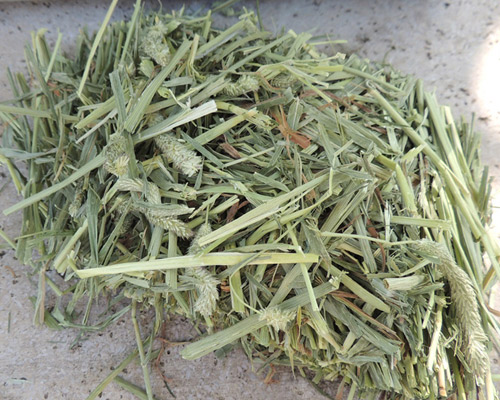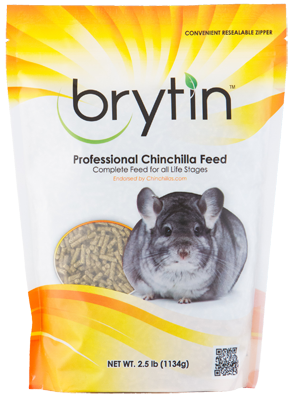Chinchilla Diet and Microbiome

by Dr. Ed Bonnette, PhD and Laurie Schmelzle
April 24, 2020 | Updated: September 1, 2022
When thinking about chinchilla nutrition, it is important to realize that many health problems start with improper diet. The chinchilla’s number one line of defense against pathogens and disease is its own immune system, which depends strongly on nutrition and the chinchilla’s gut microbiome. It is up to the owner to provide the proper ‘building blocks’ for the chinchilla to maintain a healthy immune system and optimal health.
It is helpful to understand a little bit about the different types of digestive systems in the animal world, to better understand the chinchilla’s digestive system. Humans and pigs have a monogastric digestive system. Most of their digestion takes place in the stomach, and they don’t do well extracting nutrients from high fiber diets. Next are the ruminants, including sheep, goats, cattle, and deer. Ruminants have a four-chambered stomach, where most of their digestion takes place. The four chamber stomach of a cow has tremendous capacity, holding 55-60 gallons. The rumen is full of bacteria and protozoa, which breaks down the fiber and makes energy and lots of ‘baby bacteria/protozoa’ that are digested themselves, for they are an excellent protein source. Chinchillas belong to a class called ‘hind-gut fermenters’ which also includes horses, rabbits, and oddly, ostriches. These animals ferment their forages in the hind gut using basically the same bacteria and protozoa that the cows have. The hind gut is composed of the cecum (shaped more or less like a balloon) and the large intestine.
In chinchillas, food first passes through the simple stomach into the small intestine, where most of the nutrients are absorbed. Then the food passes into the cecum, located between the small and large intestine. The cecum is a reservoir for bacteria and protozoa - the microbiome that digests fiber and produces energy. Last, what is left passes to the large intestine, which is responsible for fermentation, storage and extracting water.
The function of the cecum is to digest mainly fibers, but few carbohydrates. A problem may occur in the cecum and large intestines, which are located after the stomach and small intestines - where most of the nutrients (including carbohydrates) are digested and absorbed. This is why we worry about not overloading these hind gut fermenters with carbohydrates, and why we should be supplying good quality fibers. If carbohydrates do get to the hind gut, which is meant to digest fibers, it can cause all kinds of problems like colic in horses and enteritis/bloat in small mammals. When too many carbohydrates pass into the hind gut, it causes an unhealthy explosion of bacterium feeding on carbohydrates and producing acids and gases. This process turns the microbiome of the cecum into an unfavorable environment, in turn causing pain and enteritis in the chinchilla.
As we described earlier, fermentation occurs after the small intestine, so any nutrients produced during fermentation will not be absorbed well. The energy will be absorbed, but not the b-complex vitamins and proteins. Since nature does not allow much to be wasted, these hind gut fermenters (horses, rabbits, and chinchillas) practice something called coprophagy. Basically, they eat their own ‘special or soft poop,’ which contains b-complex vitamins and amino acids. They tend to consume the soft feces at night, so most people do not realize it has happened. The chinchilla is also unique in the animal kingdom, in that it has one of the longest digestive tracts relative to its body size. The digestive system of the chinchilla is able to extract the most possible nutrients from their sparse native diet. This is why the manure droppings you do see have had almost every bit of nutrition removed.
 With these digestive processes in mind and also knowing the specific requirements of the heavily furred chinchilla, skilled nutritionists have created high quality species-specific complete feeds for chinchillas. The definition of a complete feed is one that supplies all the micronutrients, macronutrients, and fiber a chinchilla needs, without additional supplementation. However, nutritionists also try to leave room in their formulations for hay, and just a few treats, with a heavy emphasis on the word ‘few.’ Chinchilla owners needs to be aware that the nutrient content of a complete feed is such that when a portion of the chinchilla’s diet is substituted with something else, the chinchilla is missing some of the required nutrients, or the correct ratios of nutrients. Therefore, it is important not to substitute a significant percent of the chinchilla’s complete feed with other things. For example, if the complete feed contains 100% of the chinchilla’s recommended daily requirement of vitamins and minerals, anything else they eat will displace their nutrient levels and ratios. Chinchillas eat so very little, that chinchilla owners need to make every bite count. Treats should be healthy, should not contain sugar, and should be given sparingly. Otherwise, the owner can do more harm than good, causing possible nutrient deficiencies or enteritis.
With these digestive processes in mind and also knowing the specific requirements of the heavily furred chinchilla, skilled nutritionists have created high quality species-specific complete feeds for chinchillas. The definition of a complete feed is one that supplies all the micronutrients, macronutrients, and fiber a chinchilla needs, without additional supplementation. However, nutritionists also try to leave room in their formulations for hay, and just a few treats, with a heavy emphasis on the word ‘few.’ Chinchilla owners needs to be aware that the nutrient content of a complete feed is such that when a portion of the chinchilla’s diet is substituted with something else, the chinchilla is missing some of the required nutrients, or the correct ratios of nutrients. Therefore, it is important not to substitute a significant percent of the chinchilla’s complete feed with other things. For example, if the complete feed contains 100% of the chinchilla’s recommended daily requirement of vitamins and minerals, anything else they eat will displace their nutrient levels and ratios. Chinchillas eat so very little, that chinchilla owners need to make every bite count. Treats should be healthy, should not contain sugar, and should be given sparingly. Otherwise, the owner can do more harm than good, causing possible nutrient deficiencies or enteritis.
Over the years, Chinchillas.com has received a few questions from chinchilla owners asking whether it is okay to feed rabbit feed to chinchillas. To properly answer the question, we reached out to our PhD nutritionist; an expert in small animal diets. He commented that particular brands of rabbit feed are good “if you are making a nice rabbit!" However, chinchillas have different dietary requirements than rabbits, and although rabbits and chinchillas are both hind gut fermenters, they have different goals (high quality fur for the chinchilla, versus a larger number of babies for the rabbit). The heavy fur produced by a chinchilla requires high levels of amino acids from a variety of different protein sources, with a heavy emphasis on the amino acids methionine and lysine. Also, a large number of other nutrients are involved including essential fatty acids, vitamins, and trace minerals. Copper is getting a lot of attention lately, and it is needed in very specific amounts for fur growth - but not too much. Too much copper can cause intestinal problems. Our nutritionist gave the following analogy:
In a chinchilla, you want quality hair. Please remember that the feed supplies the raw ingredients to make parts of the body. Think about tearing apart a Ford truck to make a Cadillac. It will not work that well. If we want the ‘Cadillac’ hair coat in a chinchilla, like the car, you have to also pay a little more for it. It goes back to ‘you usually get what you pay for.’ ”
 The best thing a chinchilla owner can do is to invest in a high-quality complete feed formulated specifically for chinchillas.
The best thing a chinchilla owner can do is to invest in a high-quality complete feed formulated specifically for chinchillas.
Knowing how important a chinchilla’s microbiome is to digestion, it is important not to disturb this microbiome. The microbiome ‘adapts’ to the chinchilla’s diet. Therefore, it is important not to change the chinchilla’s feed too quickly. If owners need to change from one brand of feed to another, they should do so slowly over the course of 7-10 days. On the first day, the chinchilla should only get about 10% of the new feed, and that percent can be increased by an additional 10% each day.
Chinchillas do well with the addition of a clean, high-quality grass hay like Timothy. Other grass hays are fine, but any new type of hay should be added slowly. Keep in mind that alfalfa and clover are legumes, not grass. Legumes are much higher in protein and calcium than grass hays, and should only be given in small amounts, in certain circumstances. And last, chinchillas always need clean, fresh water. Water contains different microbes in different regions. Therefore, when moving chinchillas long distances, it is important to use distilled water until the chinchillas recover from the stress of the move. Once recovered, they can be slowly introduced to the local water source. In areas that do not have good quality tap water, the water should be further purified. Chinchillas favor glass water bottles over plastic. With either one, the bottles should be sterilized (standard dishwashers generally do the job) once a week. When moving chinchillas long distances, we recommend keeping them on their normal brand of feed, and adding vitamin C and probiotics to help support the immune system and the microbiome. This is especially important when the animals are under stress and are being exposed to pathogens their immune systems have not encountered before.
Each year, researchers are learning even more about the connections between diet, health, gut function, immune function, and disease processes. They are even exploring the connection between diet and environment, and gene expression - in an emerging field called epigenetics. To maintain healthy chinchillas, it is important to focus on the diet, to be open minded, and to continue to learn.